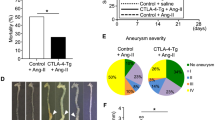Summary
The antibody against AT1-EC2 plays a role in some kinds of inflammatory vascular diseases including malignant hypertension, preeclampsia, and renal-allograft rejection, but the detailed mechanisms remain unclear. In order to investigate the changes of NADPH oxidase and reactive oxygen species in the aorta in a mouse model which can produce AT1-EC2 antibody by active immunization with AT1-EC2 peptide, 15 mice were divided into three groups: control group, AT1-EC2-immunized group, and AT1-EC2-immunized and valsartan-treated group. In AT1-EC2-immunized group and AT1-EC2-immunized and valsartan-treated group, the mice were immunized by 50 μg peptide subcutaneously at multiple points for 4 times: 0, 5, 10, and 15 days after the experiment. In AT1-EC2-immunized and valsartan-treated group, valsartan was given at a dose of 100 mg/kg every day for 20 days. After the experiment, the mice were sacrificed under anesthesia and the aortas were obtained and frozen in liquid nitrogen for the preparation of frozen section slides and other experiments. The titer of AT1-EC2 was assayed by using ELISA. The level of NOX1 mRNA in the aorta was determined by using RT-PCR. The expression of NOX1 was detected by using Western blotting. Confocal scanning microscopy was used to assay the α-actin and NOX1 expression in the aortic tissue. The O2∸ production was detected in situ after DHE staining. The mice produced high level antibody against AT1-EC2 in AT1-EC2-immunized group and AT1-EC2-immunized and valsartan-treated group, and the level of NOX1 mRNA in the aortic tissues was 1.6±0.4 times higher and the NOX1 protein expression was higher in AT1-EC2-immunized group than in control group. There were no significant differences in the level of NOX1 mRNA and protein expression between control group and AT1-EC2-immunized and valsartan-treated group. The expression and co-localization of α-actin and NOX1 in AT1-EC2-immunized group increased significantly as compared with those in control group, and the O2∸ production increased about 2.7 times as compared with control group. There were no significant differences between control group and AT1-EC2-immunized and valsartan-treated group. It is concluded that active immunization with AT1-EC2 can activate NOX1-ROS, and increase vascular inflammation, which can be inhibited by AT1 receptor blocker valsartan. This may partially explain the mechanism of the pathogenesis of inflammatory vascular diseases related to antibody against AT1-EC2.
Similar content being viewed by others
References
Wallukat G, Homuth V, Fischer T, et al. Patients with preeclampsia develop agonistic autoantibodies against the angiotensin AT1 receptor. J Clin Invest, 1999,103(7):945–952
Fu ML, Herlitz H, Schulze W, et al. Autoantibodies against the angiotensin receptor (AT1) in patients with hypertension. J Hypertens, 2000,18(7):945–953
Liao YH, Wei YM, Wang M, et al. Autoantibodies against AT1-receptor and alpha1-adrenergic receptor in patients with hypertension. Hypertens Res, 2002,25(4):641–646
Luo YS, Liao YH, Wang M, et al. Experimental study on AT1 receptor-peptide-induced myocardial immune damage in rats. J Tongji Med Univ Med Sci, 2001,21(3): 198–201
Dragun D, Müller DN, Bräsen JH, et al. Angiotensin II type 1-receptor activating antibodies in renal-allograft rejection. N Engl J Med, 2005,352(6):558–569
Dechend R, Müller DN, Wallukat G, et al. Activating auto-antibodies against the AT1 receptor in preeclampsia. Autoimmun Rev, 2005,4(1):61–65
Li PL, Zhang Y, Yi F. Lipid raft redox signaling platforms in endothelial dysfunction. Antioxid Redox Signal, 2007,9(9):1457–1470
Bedard K, Krause KH. The NOX family of ROS-generating NADPH oxidases: physiology and pathophysiology. Physiol Rev, 2007,87(1):245–313
Ago T, Kuroda J, Kamouchi M, et al. Pathophysiological roles of NADPH oxidase/nox family proteins in the vascular system. Circ J, 2011,75(8):1791–1800
Wang B, Liao YH, Zhou Z, et al. Arterial structure changes in rats immunized by AT1-receptor peptide. Heart Vessels, 2005,20(4):153–158
Dikalova A, Clempus R, Lassègue B, et al. Nox1 overexpression potentiates angiotensin II-induced hypertension and vascular smooth muscle hypertrophy in transgenic mice. Circulation, 2005,112(17):2668–2676
Sorescu D, Weiss D, Lassègue B, et al. Superoxide production and expression of nox family proteins in human atherosclerosis. Circulation, 2002,105(12):1429–1435
Jankov RP, Kantores C, Pan J, et al. Contribution of xanthine oxidase-derived superoxide to chronic hypoxic pulmonary hypertension in neonatal rats. Am J Physiol Lung Cell Mol Physiol, 2008,294(2):L233–245
Zhu F, Sun YX, Liao YH, et al. Agonistic AT(1) receptor autoantibody increases in serum of patients with refractory hypertension and improves Ca(2+) mobilization in cultured rat vascular smooth muscle cells. Cell Mol Immunol, 2008,5(3):209–217
Dechend R, Homuth V, Wallukat G, et al. AT(1) receptor agonistic antibodies from preeclamptic patients cause vascular cells to express tissue factor. Circulation, 2000,101(20):2382–2387
Dechend R, Viedt C, Müller DN, et al. AT1 receptor agonistic antibodies from preeclamptic patients stimulate NADPH oxidase. Circulation, 2003,107(12): 1632–1639
Dworakowski R, Alom-Ruiz SP, Shah AM. NADPH oxidase-derived reactive oxygen species in the regulation of endothelial phenotype. Pharmacol Rep, 2008,60(1):21–28
Garrido AM, Griendling KK. NADPH oxidases and angiotensin II receptor signaling. Mol Cell Endocrinol, 2009,302(2):148–158
Author information
Authors and Affiliations
Corresponding author
Additional information
This project was supported by National Natural Science Foundation of China (No. 30871069).
Rights and permissions
About this article
Cite this article
Wei, Y., Chen, Y., Li, Z. et al. Expression of NADPH oxidase and production of reactive oxygen species in aorta in an active immunization mouse model with AT1-EC2 peptide. J. Huazhong Univ. Sci. Technol. [Med. Sci.] 32, 490–494 (2012). https://doi.org/10.1007/s11596-012-0085-8
Received:
Published:
Issue Date:
DOI: https://doi.org/10.1007/s11596-012-0085-8




